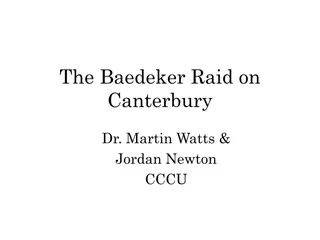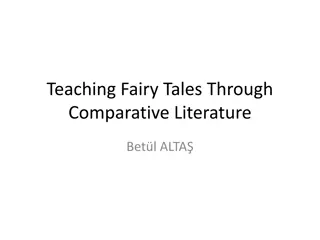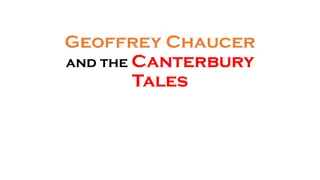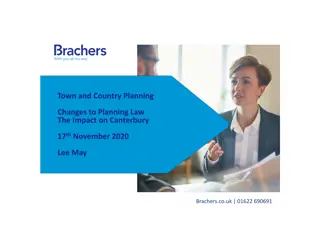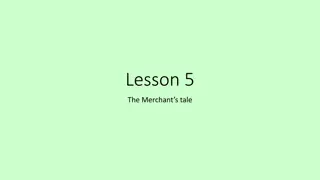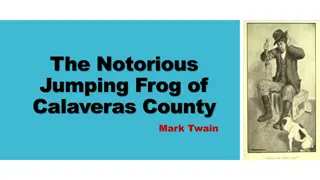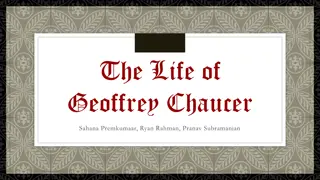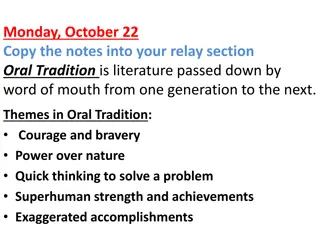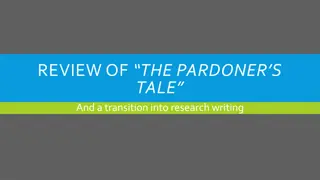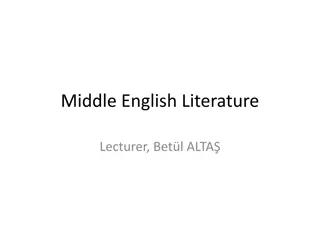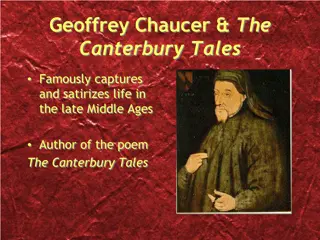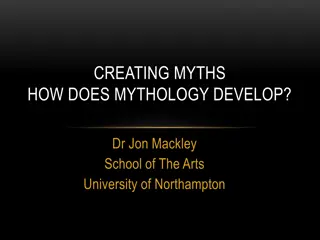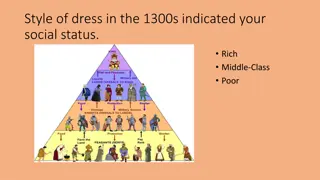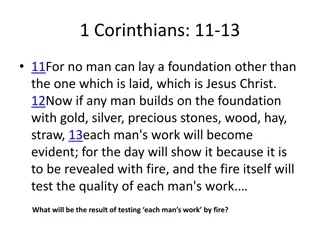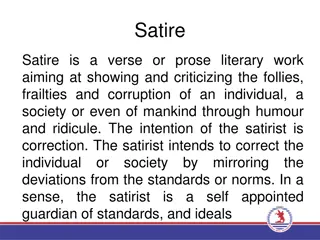Insights into Geoffrey Chaucer and The Canterbury Tales
Geoffrey Chaucer, a versatile figure, crafted literary works in different periods, influenced by French, Italian, and English styles. His masterpiece, The Canterbury Tales, unfolds a captivating plot of diverse characters engaged in storytelling on a pilgrimage to Canterbury Cathedral in a framework set at the Tabard Inn. The tales reflect societal satire, character stereotypes, and individual depth, presenting a rich tapestry of medieval life and values.
Download Presentation

Please find below an Image/Link to download the presentation.
The content on the website is provided AS IS for your information and personal use only. It may not be sold, licensed, or shared on other websites without obtaining consent from the author.If you encounter any issues during the download, it is possible that the publisher has removed the file from their server.
You are allowed to download the files provided on this website for personal or commercial use, subject to the condition that they are used lawfully. All files are the property of their respective owners.
The content on the website is provided AS IS for your information and personal use only. It may not be sold, licensed, or shared on other websites without obtaining consent from the author.
E N D
Presentation Transcript
Geoffrey Chaucer c.1343-1400 Son of a wine-merchant He received a good education: he studied the classics, law, theology, astronomy and medicine He was a royal servant: he was in the service of Elizabeth of Ulster, Edward III s daughter-in- law He was a soldier: he joined the army to fight against the French during the Hundred Years War He travelled a lot as diplomat He was the first poet to be buried in Westminister Abbey, in the Poets Corner
The literary periods Chaucer s literary production can be divided in three periods according to the main influences on his production: The FRENCH PERIOD: he wrote poems modelled on French romance style like The Romaunt of the Rose, about courtly love; The ITALIAN PERIOD: he wrote allegorical poems inspired by Boccaccio and Dante s works. The FINAL PERIOD or ENGLISH PERIOD: from 1387 onwards, Chaucer worked exclusively on his masterpiece: The Canterbury Tales
The Canterbury Tales: The characters It is an estates satire it satirizes/mocks/criticizes the abuses and exaggerations of the three estates* The characters belong to the three orders of society *THE NOBLES, THE CLERGY and THE PEASANTS The characters are stereotyped (the monk and his strong faith; the knight and his values code..) but they emerge also as individuals with their own personality, lifestyle, experiences (realistic details, life-like dialogues and psychological characterisation)
Plot Cycle of stories told by different narrators within a framework described in the General Prologue The narrator meets 29 pilgrims at the Tabard Inn in London and travels with them to the shrine of St. Thomas Becket in Canterbury. The host of the Inn suggests that each pilgrim should tell two stories on the way to Canterbury and two on the way back; the best storyteller will win a free supper at the inn.
Why a pilgrimage to Canterbury? Canterbury Cathedral is the shrine of Thomas Beckett, England s first martyr; Taking a pilgrimage was common in Chaucer s day; People went on a pilgrimage to ask for healing or forgiveness of sins but also to socialise
The language During the Middle Ages three languages were spoken in England: French (spoken by the Norman aristocracy); Anglo-Saxon (spoken by the natives) and Latin (spoken by the Church). By the time Chaucer wrote The Canterbury Tales, English slowly began to re-emerge. English replaced French as the language of education in the local schools; English was becoming the language of the government; A lot of literary works were written in English
Thanks to The Canterbury Tales the Middle English became the standard literary language. What was precisely the language used by Chaucer? The East Midland dialect spoken in London. This dialect gradually became a standard language because it was a very simple dialect in terms of grammar and syntax and it was the dialect used by the aristocratic and literary circles of the country.
Why is The C. Tales an allegorical work? The pilgrims journey from London to Canterbury represents the journey from Earth to Heaven. When the journey begins, we have a sinful group of pilgrims with vices and dirty secrets. Their pilgrimage is meant to be a journey of repentance, so that by the time they reach Canterbury, their sins will be washed away by telling the stories. Thus in this allegory, the tavern represents the sinful life on Earth,while Canterbury represents the sinfree life in heaven that all people are trying to reach.
To sum up Was Chaucer exclusively a poet in his lifetime? What about his education? What are the literary periods of Chaucer s production? Why is The Canterbury Tales defined as an estates satire? How are the characters described? What is the framework of The Canterbury Tales? Why is the Canterbury Cathedral the destination of this pilgrimage? What is the language used by Chaucer in the C. T.? What is the allegorical meaning of The Canterbury Tales?
April sweet showers Quando in Aprile cadono le dolci piogge E penetrano la siccit di Marzo alle radici, e tutte Le vene sono bagnate nel liquore di un potere tale Che genera i fiori Quando anche Zeffiro con il suo dolce soffio Esala una brezza in ogni bosco e brughiera Sui teneri germogli, e il giovane sole Ha compiuto il suo mezzo corso nel segno dell'Ariete, Ed i piccoli uccelli stanno cantando una melodia Che spazza via la notte con l'occhio aperto (Cos la natura li punge e stimola i loro cuori) When in April the sweet showers fall And pierce the drought of March to the root, and all The veins are bathed in liquor of such power As brings about the engendering of the flower, When also Zephyrus with his sweet breath Exhales an air in every grove and heath Upon the tender shoots, and the young sun His half-course in the sign of the Ram has run, And the small fowl are making melody That sleep away the night with open eye (So nature pricks them and their heart engages)
Then people long to go on pilgrimages And palmers long to seek the stranger strands Of far-off saints, hallowed in sundry lands, And specially, from every shire's end Of England, down to Canterbury they wend To seek the holy blissful martyr, quick To give his help to them when they were sick. allora la gente desidera andare in pellegrinaggio ed i palmieri desiderano cercare i lidi forestieri dei santi lontani venerati in diversi posti, e specialmente, al confine di ogni contea dell'Inghilterra, gi verso Canterbury si dirigono per cercare il santa beato martire, pronto a dar loro il suo aiuto quando erano malati
Reading comprehension How opens the Genaral Prologue? Which season is described? Which elements announce its arrival? How would you describe the language used?



